Water Resource Assessment and Management in Dalha Basalts Aquifer (SW Djibouti) Using Numerical Modeling
Abstract
1. Introduction
- Developing a numerical model of the Dalha aquifer to evaluate its resources;
- Simulating rainfall patterns for the Republic of Djibouti up to 2100, based on the RCP 2.6 climate scenario provided by the IPCC;
- Estimating groundwater recharge using the simulated rainfall data;
- Analyzing the aquifer’s response to projected climate scenarios by incorporating the recharge data into the aquifer model.
2. Materials and Methods
2.1. Study Area
2.1.1. Geological Setting
2.1.2. Hydrogeological Setting
2.1.3. Meteorological Data
2.2. Climate Change Scenario
2.3. Modeling Approach
2.4. Model Calibration
2.5. Sustainable Yield Concept
2.6. Optimization Procedure of the Exploitation of the Dalha Aquifer
- Extracting each section (eastern, central, and western) from the Dalha general model,
- Refining the sub-model,
- Simulating and optimizing pumping scenarios.
3. Results and Discussion
3.1. Conceptual Model of the Dalha Aquifer
3.1.1. Boundary Conditions and Gridding
- to the northeast by the Hambocto wadi,
- to the southeast by the Mabla rhyolites on which the Dalha basalts rest in discordance,
- to the south and southwest by the Dabadère wadi,
- to the north by the alluvial fans of the Grand Bara,
- and to the northwest by the stratoid basalts (see geological map of the study area, Figure 2).
3.1.2. Recharge and Evaporation
- Diffuse Recharge. This occurs through the outcrop surface of the basalts. However, the surface of the Dalha basalts at outcrop locations is often significantly altered and, in some cases, argillized. These conditions severely limit the potential for substantial diffuse infiltration.
- Preferential Recharge. This occurs via the sedimentary formations in the wadi valleys. These formations contain alluvial interflow layers, which facilitate infiltration during wadi flow episodes. These sedimentary aquifers act as transfer zones, supplying water to the underlying basaltic aquifer through faults [16]. This recharge mechanism is the dominant process for basaltic aquifers. The volume of water infiltrated through these interflow aquifers constitutes the primary recharge source for the Dalha basalts aquifer.
3.2. Simulation of Climate Change Impact up to 2100 Under RCP 2.6 Scenario
3.2.1. Dalha Model Calibration
3.2.2. Optimization of the Exploitation of the Dalha Aquifer Using the Numerical Model
- The water supply for the regional capital, Dikhil, must remain secure.
- The significant drawdowns that are currently observed, caused by the discharge rates of the Dikhil wellfield and Db2 wells, need to be reduced.
- Areas where discharge rates could be increased need to be identified.
- It must be ensured that total extraction does not exceed a substantial portion of the aquifer’s average recharge, aligning with the concept of Sustainable Yield. This requires a balanced approach, reconciling the growing water demands driven by regional socioeconomic development with essential environmental considerations.
- Maximum drawdown at each well: 20 m,
- Maximum pumping rate at each well: 1000 m3/d.
3.3. Transient Modeling and Climate Change Impact Analysis over the 2001–2100 Period
3.3.1. Preliminary Considerations
3.3.2. Recharge and Boundary Conditions of the Transient Model
3.3.3. Predicted Results and Discussions on the Impact of Climate Change
- In the early years, a piezometric decline is observed over several consecutive years in the central and western regions, whereas the eastern region does not show this characteristic. The magnitude of this decline is relatively small (in the order of meters) in the central region. However, in the western region, it is significantly more pronounced, reaching up to ten meters. These variations in amplitude are attributed to differences in pumping rates, the hydraulic properties of the aquifer at various well locations, and the relatively low precipitation levels projected under the RCP 2.6 scenario during these initial years.
- The overall piezometric trend then shifts downward, with a slight decrease in the central and eastern regions but a much steeper decline in the west. Toward the later years, however, the trend stabilizes around an average value.
- The impact of heavy rainfall events (>400 mm) simulated under the RCP 2.6 scenario is clearly reflected in the data. However, it is notable that the aquifer depletes rapidly when followed by a dry year. The prolonged drought period from 2079 to 2085 is also distinctly evident in the records.
4. Conclusions
- Real-Time Groundwater Monitoring: (i) Install automated sensors to track water levels and quality, focusing on overexploited areas like the Dikhil wellfield, and (ii) enable real-time data collection for early warnings on overuse.
- Artificial and Managed Aquifer Recharge (MAR): (i) Assess the feasibility of recharge during wet periods and (ii) identify optimal MAR zones to enhance aquifer resilience.
- Alternative Water Sources and Water Demand Management: (i) Explore rainwater harvesting and wastewater reuse to ease reliance on the aquifer and (ii) promote water-saving practices in agriculture, which is a major consumer.
- Capacity Building and Stakeholder Engagement: (i) Train local water authorities (e.g., ONEAD) in model operation and monitoring and (ii) encourage community participation in groundwater conservation.
- Regular Model Updates: (i) Continuously update the model with new data to refine forecasts and (ii) simulate additional climate scenarios (e.g., RCP 4.5 and RCP 8.5) for better preparedness.
Author Contributions
Funding
Data Availability Statement
Acknowledgments
Conflicts of Interest
Abbreviations
| RoD | Republic of Djibouti |
| ONEAD | Office National de l’Eau et de l’Assainissement de Djibouti |
| RCP | Representative Concentration Pathway |
| IPCC | Intergovernmental Panel on Climate Change |
| DIA | Djibouti International Airport |
| IGAD-CPAC | Climate Prediction and Application Center |
| GCM | Global Climate Model |
References
- Mukherjee, A.; Saha, D.; Harvey, C.F.; Taylor, R.G.; Ahmed, K.M.; Bhanja, S.N. Groundwater systems of the Indian sub-continent. J. Hydrol. Reg. Stud. 2015, 4, 1–14. [Google Scholar]
- Watto, M.A.; Mugera, A.W. Econometric estimation of groundwater irrigation efficiency of cotton cultivation farms in Pakistan. J. Hydrol. Reg. Stud. 2015, 4, 193–211. [Google Scholar]
- Jalludin, M. Groundwater ressources and challenges of future water supply of the Republic of Djibouti under arid climate (Horn of Africa). In Aquifer Systems Management; CRC Press: Dijon, France, 2006. [Google Scholar]
- Steyl, G.; Dennis, I. Review of coastal-area aquifers in Africa. Hydrogeol. J. 2010, 18, 217–225. [Google Scholar]
- Walraevens, K.; Mjemah, I.C.; Mtoni, Y.; Van Camp, M. Sources of salinity and urban pollution in the Quaternary sand aquifers of Dar es Salaam, Tanzania. J. Afr. Earth Sci. 2015, 102, 149–165. [Google Scholar] [CrossRef]
- Golian, M.; Saffarzadeh, A.; Katibeh, H.; Mahdad, M.; Saadat, H.; Khazaei, M.; Sametzadeh, E.; Ahmadi, A.; Sharifi Teshnizi, E.; Samadi Darafshani, M.; et al. Consequences of groundwater overexploitation on land subsidence in Fars Province of Iran and its mitigation management programme. Water Environ. J. 2021, 35, 975–985. [Google Scholar] [CrossRef]
- Taucare, M.; Viguier, B.; Figueroa, R.; Daniele, L. The alarming state of Central Chile's groundwater resources: A paradigmatic case of a lasting overexploitation. Sci. Total Environ. 2024, 906, 167723. [Google Scholar] [CrossRef]
- Schuch, C.S.; Galvão, P.; de Melo, M.C.; Pereira, S. Overexploitation assessment in an urban karst aquifer: The case of Sete Lagoas (MG), Brazil. Environ. Res. 2023, 236 Pt 2, 116820. [Google Scholar] [CrossRef]
- Hinkel, J.; Brown, S.; Exner, L.; Nicholls, R.J.; Vafeidis, A.T.; Kebede, A.S. Sea-level rise impacts on Africa and the effects of mitigation andadaptation: An application of DIVA. Reg. Environ. Chang. 2012, 12, 207–224. [Google Scholar]
- Du, X.; Lu, X.; Hou, J.; Ye, X. Improving the Reliability of Numerical Groundwater Modeling in a Data-Sparse Region. Water 2018, 10, 289. [Google Scholar] [CrossRef]
- Razack, M.; Furi, W.; Fanta, F.; Shiferaw, A. Water Resource Assessment of a Complex Volcanic System Under Semi-Arid Climate Using Numerical Modeling: The Borena Basin in Southern Ethiopia. Water 2020, 12, 276. [Google Scholar] [CrossRef]
- Worldometer. Available online: www.worldometers.info/world-population/djibouti-population/ (accessed on 14 March 2025).
- Theodora. Available online: https://theodora.com/ (accessed on 14 March 2025).
- Aboubaker, M.; Jalludin, M.; Razack, M. Hydrochemistry of a complex volcano-sedimentary aquifer using major ions and environmental isotopes data: Dalha basalts aquifer, southwest of Republic of Djibouti. Environ. Earth Sci. 2013, 70, 3335–3349. [Google Scholar] [CrossRef]
- Demange, J.; Stieljes, L. Géologie de la région sud-ouest du TFAI (région Lac-Abhé-Lac Asal). Geology of the southwestern TFAI (Region of Lake Asal-Lake ABHE). Bull. BRGM 1975, 2, 83–114. (In French) [Google Scholar]
- Varet, J.; Gasse, F. Carte géologique de l'Afar central et méridional. Ethiopie et République de Djibouti; CNRS: Paris, France, 1978. [Google Scholar]
- Jalludin, M.; Anis, A.; Idriss, G.; Mohamed, I.; San Juan, B.; Gaulier, J.M.; Zotskina, E.; Gaffaneh, A.; Haga, A. Alimentation en eau potable de la ville d'Ali Sabieh. Etude hydrogéologique des basaltes de Dalha. Sci. Tech. 1990, 5, 13–21. [Google Scholar]
- Arthaud, F.; Choukroune, P.; Robineau, B. Tectonique, microtectonique et +volution structurale du golfe de Tadjourah et du sud de la D+pression Afar (R~publique de Djibouti). Bull. Soc. Géol. Fr. 1980, XXII, 909–915. [Google Scholar] [CrossRef]
- Jalludin, M. Geometric and Hydrodynamic Properties of Aquifers in Fissured Volcanic Environments Under Arid Climate. Republic of Djibouti. Ph.D. Thesis, University of Poitiers, Poitiers, France, 1993; 250p. (In French). [Google Scholar]
- BGR (Bundesanstalt für Geowissenschaften und Rohstoffe, Hanover, Germany). Inventaire et Mise en Valeur des Ressources en eau de la République de Djibouti. (Inventory and Evaluation of the Water Resources of the Republic of Djibouti). Unpublished work, 1982. [Google Scholar]
- Gamal-Eldin, H.A. Etude de l’aquifère Basaltique de la Zone de Captage de la Ville de Djibouti. République de Djibouti. Ph.D. Thesis, University Albert-Ludwig, Fribourg, Germany, 1988. [Google Scholar]
- Jalludin, M.; Razack, M. Analysis of pumping tests in fractured Dalha and stratiform basalts with regards to tectonics, hydrothermalisms and weathering. Republic of Djibouti. J. Hydrol. 1994, 155, 237–250. [Google Scholar] [CrossRef]
- Jalludin, M.; Razack, M. Assessment of hydraulic properties of sedimentary and volcanic aquifer systems under arid conditions in the Republic of Djibouti (Horn of Africa). Hydrogeol. J. 2004, 12, 159–170. [Google Scholar] [CrossRef]
- Yan, X.; Cheng, P.; Zhang, Q.; Li, X.; He, J.; Yan, X.; Zhao, W.; Wang, L. Comparisons of climate change characteristics in typical arid regions of the Northern Hemisphere. Front. Environ. Sci. 2022, 10, 1033326. [Google Scholar] [CrossRef]
- Allan, R.P.; Douville, H. An even drier future for the arid lands. Proc. Natl. Acad. Sci. USA 2023, 121, e2320840121. [Google Scholar] [CrossRef]
- Xu, L.; Zheng, C.; Ma, Y. Variations in precipitation extremes in the arid and semi-arid regions of China. Int. J. Climatol. 2020, 41, 1542–1554. [Google Scholar] [CrossRef]
- Giorgi, F.; Francisco, R. Evaluating uncertainties in the prediction of regional climate change. Geophys. Lett. 2000, 27, 1295–1298. [Google Scholar]
- Aggarwal, P.K.; Mall, R.K. Climate Change and Rice Yields in Diverse Agro-Environments of India. Effect of Uncertainties in Scenarios and Crop Models on Impact Assessment. Clim. Chang. 2002, 52, 331–343. [Google Scholar]
- Velázquez, J.A.; Schmid, J.; Ricard, S.; Muerth, M.; St-Denis, B.G.; Minville, M.; Chaumont, D.; Caya, D.; Ludwig, R.; Turcotte, R. An ensemble approach to assess hydrological models’ contribution to uncertainties in the analysis of climate change impact on water resources. Hydrol. Earth Sci. 2013, 17, 565–578. [Google Scholar]
- Mauritsen, T.; Bader, J.; Becker, T.; Behrens, J.; Bittner, M.; Brokopf, R.; Brovkin, V.; Claussen, M.; Crueger, T.; Esch, M. Developments in the MPI-M Earth System Model version 1.2 (MPI-ESM1.2) and Its Response to Increasing CO2 Concentrations. J. Adv. Model. Earth Syst. 2019, 11, 998–1038. [Google Scholar] [CrossRef] [PubMed]
- Marsland, S.J.; Haak, H.; Jungclaus, J.H.; Latif, M.; Röske, F. The Max Planck Institute global ocean/sea ice model with orthogonal curvilinear coordinates. Ocean Model. 2003, 5, 91–127. [Google Scholar] [CrossRef]
- Scanlon, B.R.; Mace, R.E.; Barrett, M.E.; Smith, B. Can we simulate regional groundwater flow in a karst system using equivalent porous media models? Case study, Barton Springs Edwards aquifer, USA. J. Hydrol. 2003, 276, 137–158. [Google Scholar] [CrossRef]
- Abusaada, M.; Sauter, M. Studying the flow dynamics of a karst aquifer system with an equivalent porous medium model. Ground Water 2013, 51, 641–650. [Google Scholar] [CrossRef]
- Fiorese, G.D.; Balacco, G.; Bruno, G.; Nikolaidis, N. Hydrogeological modelling of a coastal karst aquifer using an integrated SWAT-MODFLOW approach. Environ. Model. Softw. 2025, 183, 106249. [Google Scholar] [CrossRef]
- Harbaugh, A.W. MODFLOW-2005: The U.S. Geological Survey Modular Ground-Water Model—The Ground-Water Flow Process; U.S. Geological Survey Techniques and Methods 6–A16; USGS: Reston, VA, USA, 2005. [Google Scholar]
- Rumbaugh, J.O.; Rumbaugh, D.B. Guide to Using Groundwater Vistas (V7); Environmental Simulations, Inc.: Leesport, PA, USA, 2017; 495p. [Google Scholar]
- Hill, M.C. Methods and Guidelines for Effective Model Calibration; U.S. Geological Survey Water-Resources Investigations Report 98-4005; USGS: Denver, CO, USA, 1998; 91p. [Google Scholar]
- Knowling, M.J.; Werner, A.D. Estimability of recharge through groundwater model calibration: Insights from a field-scale steady-state example. J. Hydrol. 2016, 540, 973–987. [Google Scholar] [CrossRef]
- Hendricks Franssen, H.-J.; Stauffer, F.; Kinzelbach, W. Joint estimation of transmissivities and recharges–application: Stochastic characterization of well capture zones. J. Hydrol. 2004, 294, 87–102. [Google Scholar] [CrossRef]
- Ehtiat, M.; Mousavi, S.J.; Vaghefi, S.A.; Ghaheri, A. Analysis of recharge conceptualization in inverse groundwater modeling. Hydrol. Sci. J. 2016, 61, 2789–2801. [Google Scholar] [CrossRef]
- Doherty, J. Calibration and Uncertainty Analysis for Complex Environmental Models. In PEST Complete Theory; Watermark Numerical Computing: Brisbane, Australia, 2015; ISBN 978-0-9943786-0-6. [Google Scholar]
- De Marsily, G. De l’Identification des Systèmes Hydrogéologiques. (On the Calibration of Hydrogeologic Systems). State Thesis, University of Paris 6, Paris, France, 1978; 201p. (In French). [Google Scholar]
- Certes, C.; de Marsily, G. Application of the pilot points method to the identification of aquifer transmissivity. Adv. Water Resour. 1991, 14, 284–300. [Google Scholar] [CrossRef]
- Lavenue, M.; de Marsily, G. Three-dimensional interference test interpretation in a fractured aquifer using the pilot-point inverse method. Water Resour. Res. 2001, 37, 2659–2675. [Google Scholar]
- Razack, M. Tackling Heterogeneity in Groundwater Numerical Modeling: A Comparison of Linear and Inverse Geostatitical Approaches. Example of a Volcanic Aquifer in the East African Rift. In Groundwater: Assessment, Modelling and Management; Thangarajan, M., Vijay, P.S., Eds.; CRC Press: Boca Raton, FL, USA; Taylor & Francis Group: Abingdon, UK, 2016; Section III, Chapter 14; pp. 213–227. [Google Scholar] [CrossRef]
- Doherty, J. Ground Water Model Calibration Using Pilot Points and Regularization. Ground Water 2003, 41, 170–177. [Google Scholar] [CrossRef] [PubMed]
- Kevin Hayley, J.; Schumacher, G.; MacMillan, J.; Boutin, L.C. Highly parameterized model calibration with cloud computing: An example of regional flow model calibration in northeast Alberta, Canada. Hydrogeol. J. 2014, 22, 729–737. [Google Scholar] [CrossRef]
- Jardani, A.; Dupont, J.P.; Revil, A.; Massei, N.; Fournier, M.; Laignel, B. Geostatistical inverse modeling of the transmissivity field of a heterogeneous alluvial aquifer under tidal influence. J. Hydrol. 2012, 472–473, 287–300. [Google Scholar] [CrossRef]
- Husam Musa Baalousha, H.M.; Fahs, M.; Ramasomanana, F.; Younes, A. Effect of Pilot-Points Location on Model Calibration: Application to the Northern Karst Aquifer of Qatar. Water 2019, 11, 679. [Google Scholar] [CrossRef]
- Lee, C.H. The determination of safe yield of underground reservoirs of the closed basin type. Trans. Am. Soc. Civil Eng. 1915, 78, 148–151. [Google Scholar]
- Todd, D.K. Ground Water Hydrology; John Wiley and Sons: New York, NY, USA, 1959; p. 336. [Google Scholar]
- Freeze, R.A.; Cherry, J.A. Groundwater; Prentice-Hall: London, UK, 1979; p. 604. [Google Scholar]
- Domenico, P. Concepts and Models in Groundwater Hydrology; McGraw-Hill: New York, NY, USA, 1972; p. 405. [Google Scholar]
- Sophocleous, M. From safe yield to sustainable development of water resources—The Kansas experience. J. Hydrol. 2000, 235, 27–43. [Google Scholar] [CrossRef]
- Alley, W.M.; Leake, S.A. The Journey from Safe Yield to Sustainability. Ground Water 2004, 42, 12–16. [Google Scholar] [CrossRef]
- Maimone, M. Defining and managing sustainable yield. Ground Water 2004, 42, 809–814. [Google Scholar] [CrossRef]
- Seward, P.; Xu, Y.; Brendock, L. Sustainable groundwater use, the capture principle, and adaptive management. Water SA 2006, 32, 473–482. [Google Scholar] [CrossRef][Green Version]
- Hahn, J.Y.; Lee, N.; Kim Hahn, C.; Lee, S. The groundwater resources and sustainable yield of Cheju volcanic island, Korea. Environ. Geol. 1997, 33, 43–52. [Google Scholar]
- Miles, J.C.; Chambet, P.D. Safe yield of aquifers. J. Water Resour. Plan. Manag. 1995, 121, 1–8. [Google Scholar] [CrossRef]
- Condon, L.E.; Kollet, S.; Bierkens, M.F.P.; Fogg, G.E.; Maxwell, R.M.; Hill, M.C. Global groundwater modeling and monitoring: Opportunities and challenges. Water Resour. Res. 2021, 57, e2020WR029500. [Google Scholar] [CrossRef]
- Secci, D.; Saysel, A.K.; Uygur, I.; Yoloğlu, O.C.; Zanini, A.; Copty, N.K. Modeling for sustainable groundwater management: Interdependence and potential complementarity of process-based, data-driven and system dynamics approaches. Sci. Total Environ. 2024, 951, 175491. [Google Scholar] [CrossRef] [PubMed]
- Rödiger, T.; Geyer, S.; Odeh, T.; Siebert, C. Data scarce modelling the impact of present and future groundwater development on Jordan multiaquifer groundwater resources. Sci. Total Environ. 2023, 870, 161729. [Google Scholar] [CrossRef] [PubMed]
- Gonçalvès, J.; Nutz, A.; Séraphin, P.; Chekireb, A.; Kabiri, L.; Deschamps, P. Dealing with hydrologic data scarcity: The case of the Tindouf basin. Comptes Rendus Géosci. 2023, 355, 281–300. [Google Scholar]
- Chakroun, H.; Zemni, N.; Benhmid, A.; Dellaly, V.; Slama, F.; Bouksila, F.; Berndtsson, R. Evapotranspiration in Semi-Arid Climate: Remote Sensing vs. Soil Water Simulation. Sensors 2023, 23, 2823. [Google Scholar] [CrossRef]
- Lehmann, P.; Berli, M.; Koonce, J.E.; Or, D. Surface evaporation in arid regions: Insights from lysimeter decadal record and global application of a surface evaporation capacitor (SEC) model. Geophys. Res. Lett. 2019, 46, 9648–9657. [Google Scholar] [CrossRef]
- Wythers, K.R.; Lauenroth, W.K.; Paruelo, J.M. Bare-soil evaporation under semi-arid field conditions. Soil Sci. Soc. Am. J. 1999, 63, 1341–1349. [Google Scholar] [CrossRef]
- Mughal, I.; Jadoon, K.Z.; Mai, M.P.; Al-Mashharawi, S.; Missimer, T.M. Experimental Measurement of Diffusive Extinction Depth and Soil Moisture Gradients in a Dune Sand Aquifer in Western Saudi Arabia: Assessment of Evaporation Loss for Design of an MAR System. Water 2015, 7, 6967–6982. [Google Scholar] [CrossRef]
- Shah, N.; Nachabe, M.; Ross, M. Extinction depth and evapotranspiration from ground water under selected land covers. Ground Water 2007, 45, 329–338. [Google Scholar]
- Drias, T.; Khedidja, A.; Belloula, M.; Badraddine, S.; Saibi, H. Groundwater modelling of the Tebessa-Morsott alluvial aquifer (northeastern Algeria): A geostatistical approach. Groundw. Sustain. Dev. 2020, 11, 100444. [Google Scholar] [CrossRef]
- García-Rodríguez, M.; Antón, L.; Martinez-Santos, P. Estimating groundwater resources in remote desert environments by coupling geographic information systems with groundwater modeling (Erg Chebbi, Morocco). J. Arid Environ. 2014, 110, 19–29. [Google Scholar]
- Roldán-Cañas, J.; Moreno-Pérez, M.F. Water and Irrigation Management in Arid and Semiarid Zones. Water 2021, 13, 2446. [Google Scholar] [CrossRef]
- Borzì, I. Modeling Groundwater Resources in Data-Scarce Regions for Sustainable Management: Methodologies and Limits. Hydrology 2025, 12, 11. [Google Scholar] [CrossRef]
- Rafik, A.; Brahim, Y.A.; Amazirh, A.; Ouarani, M.; Bargam, B.; Ouatiki, H.; Bouslihim, Y.; Bouchaou, L.; Chehbouni, A. Groundwater level forecasting in a data-scarce region through remote sensing data downscaling, hydrological modeling, and machine learning: A case study from Morocco. J. Hydrol. Reg. Stud. 2023, 50, 101569. [Google Scholar]
- Näschen, K.; Diekkrüger, B.; Leemhuis, C.; Steinbach, S.; Seregina, L.S.; Thonfeld, F.; van der Linden, R. Hydrological modeling in data-scarce catchments: The Kilombero floodplain in Tanzania. Water 2018, 10, 599. [Google Scholar] [CrossRef]
- Williams, J.H.; Paillet, F.L. Geophysical Logging for Hydrogeology; The Groundwater Project: Guelph, ON, Canada, 2023. [Google Scholar] [CrossRef]
- Sinan, M.; Razack, M. Estimation of the transmissivity field of a heterogeneous alluvial aquifer using transverse resistance. Application to the Haouz groundwater (Morocco) (In French). Rev. Sci. L'eau J. Water Sci. 2006, 19, 221–232. [Google Scholar] [CrossRef][Green Version]
- Frohlich, R.K.; Kelly, W.E. The relation between hydraulic transmissivity and transverse resistance in a complicated aquifer of glacial outwash deposits. J. Hydrol. 1985, 79, 215–229. [Google Scholar]
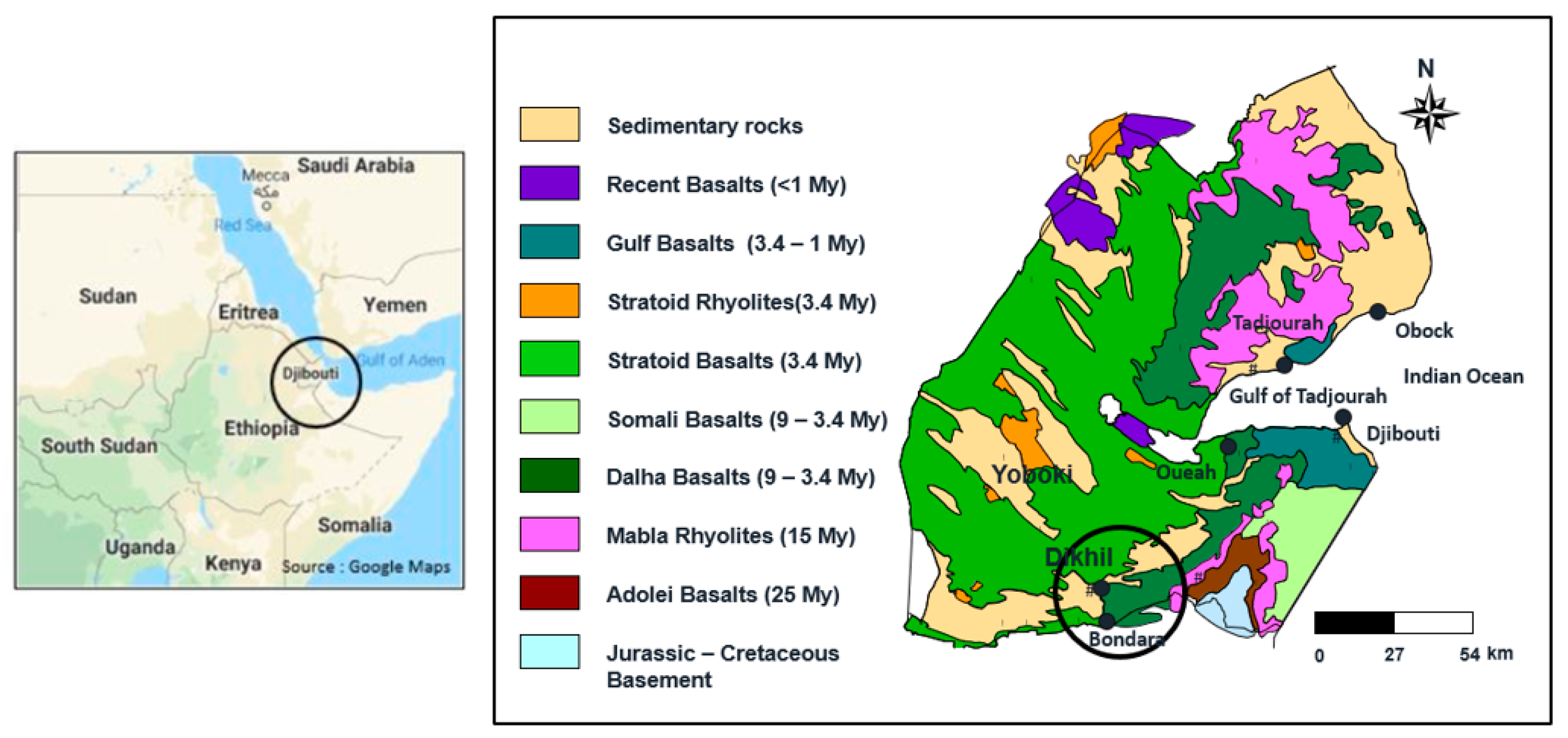
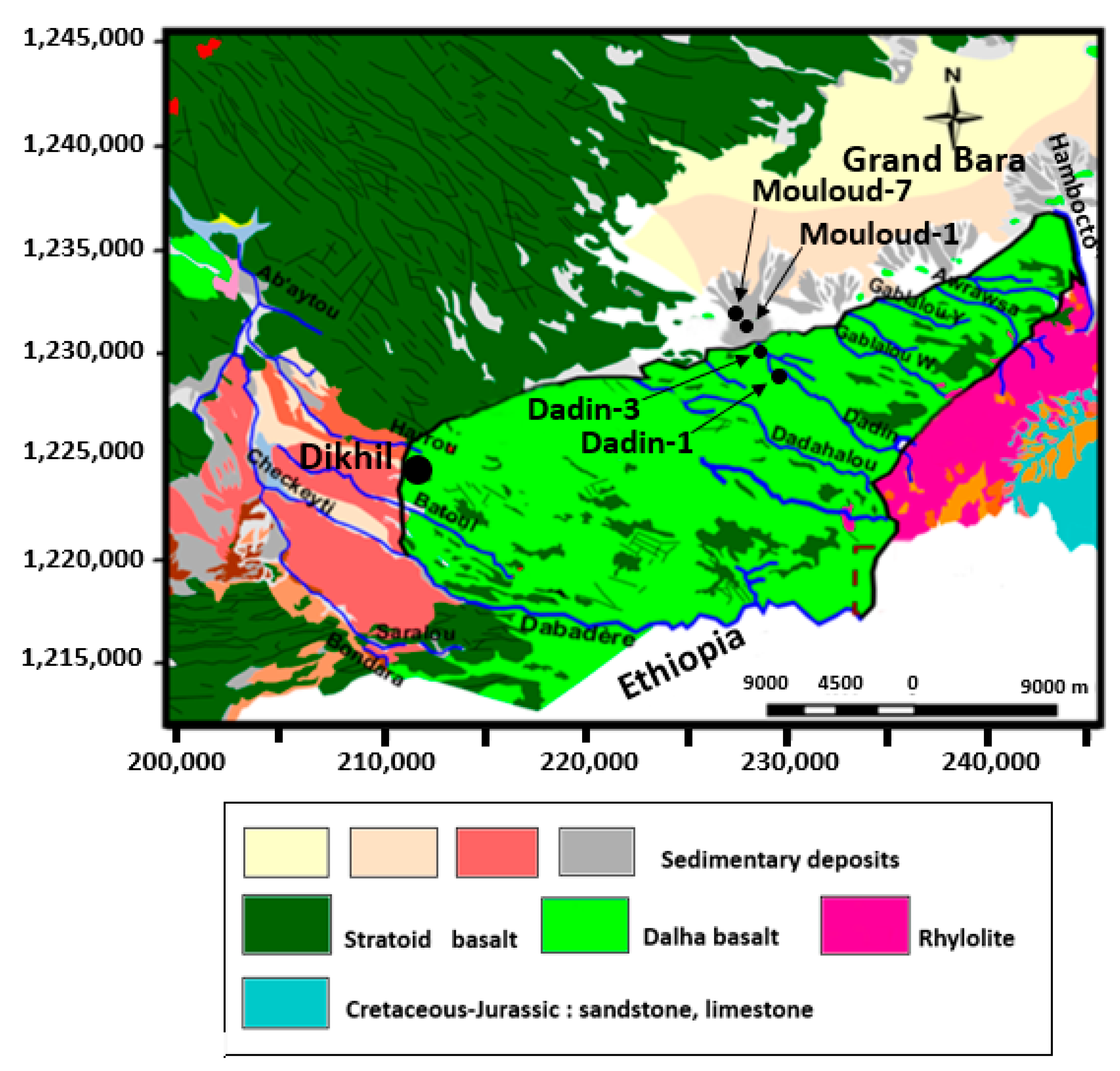
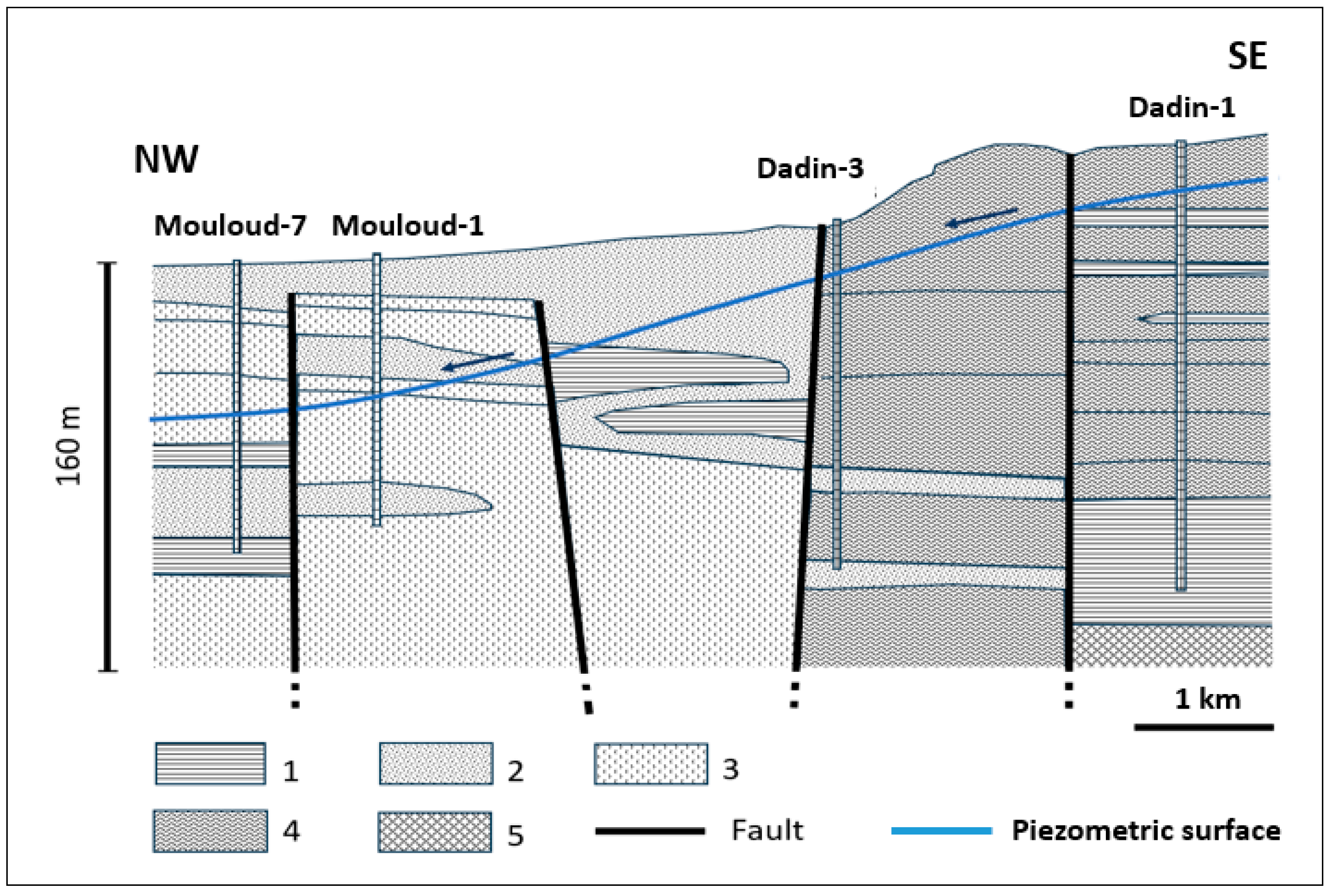
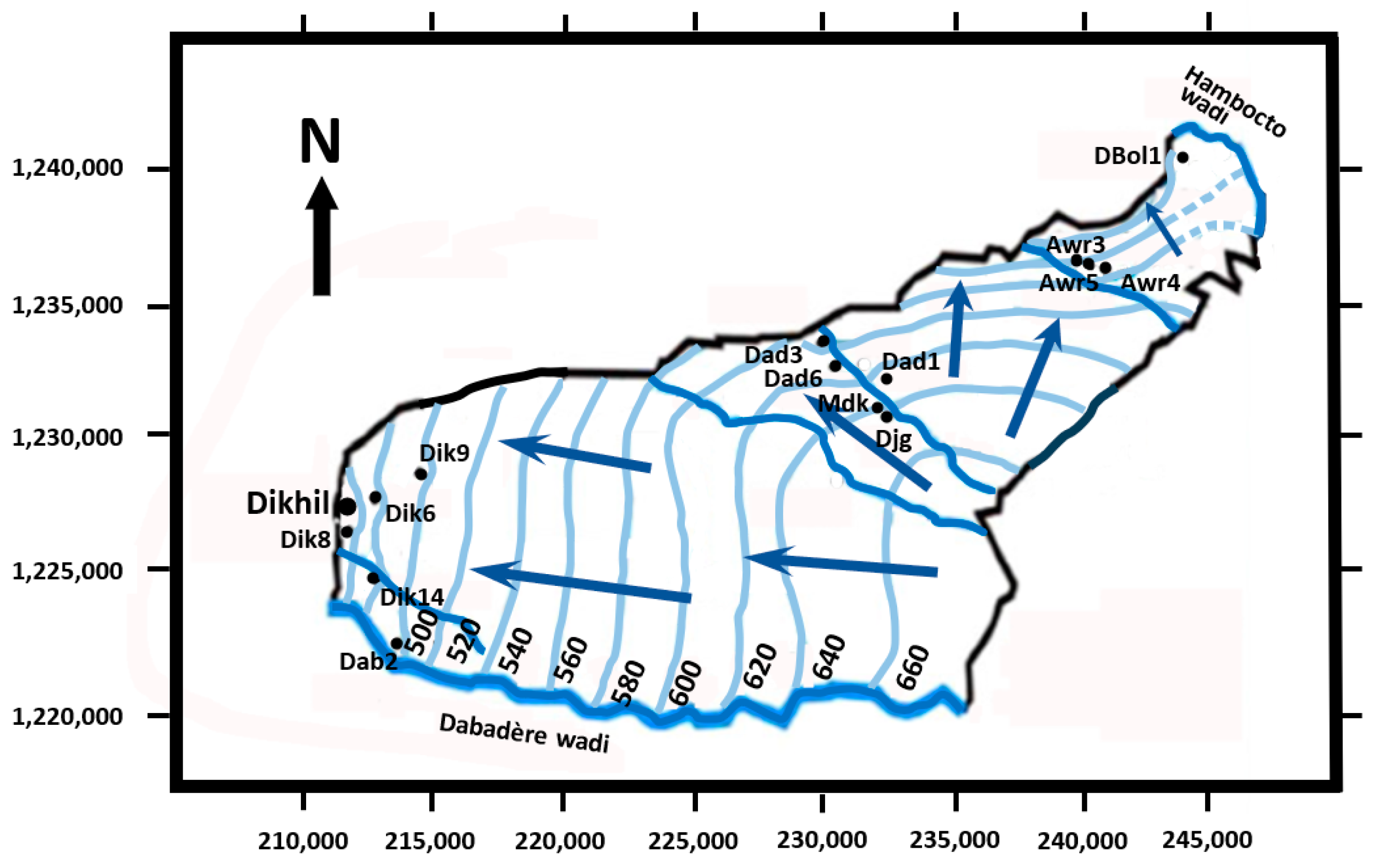




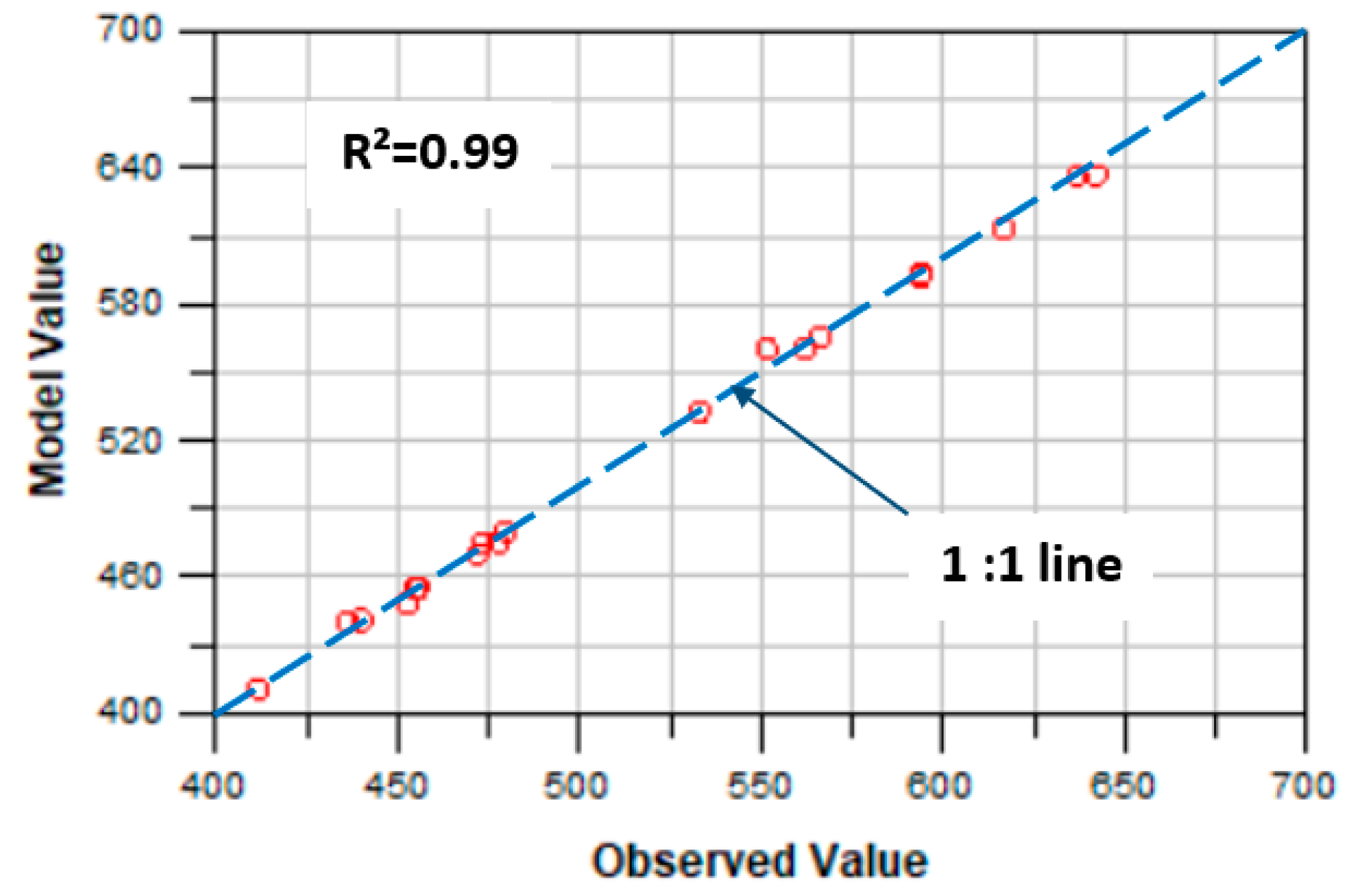
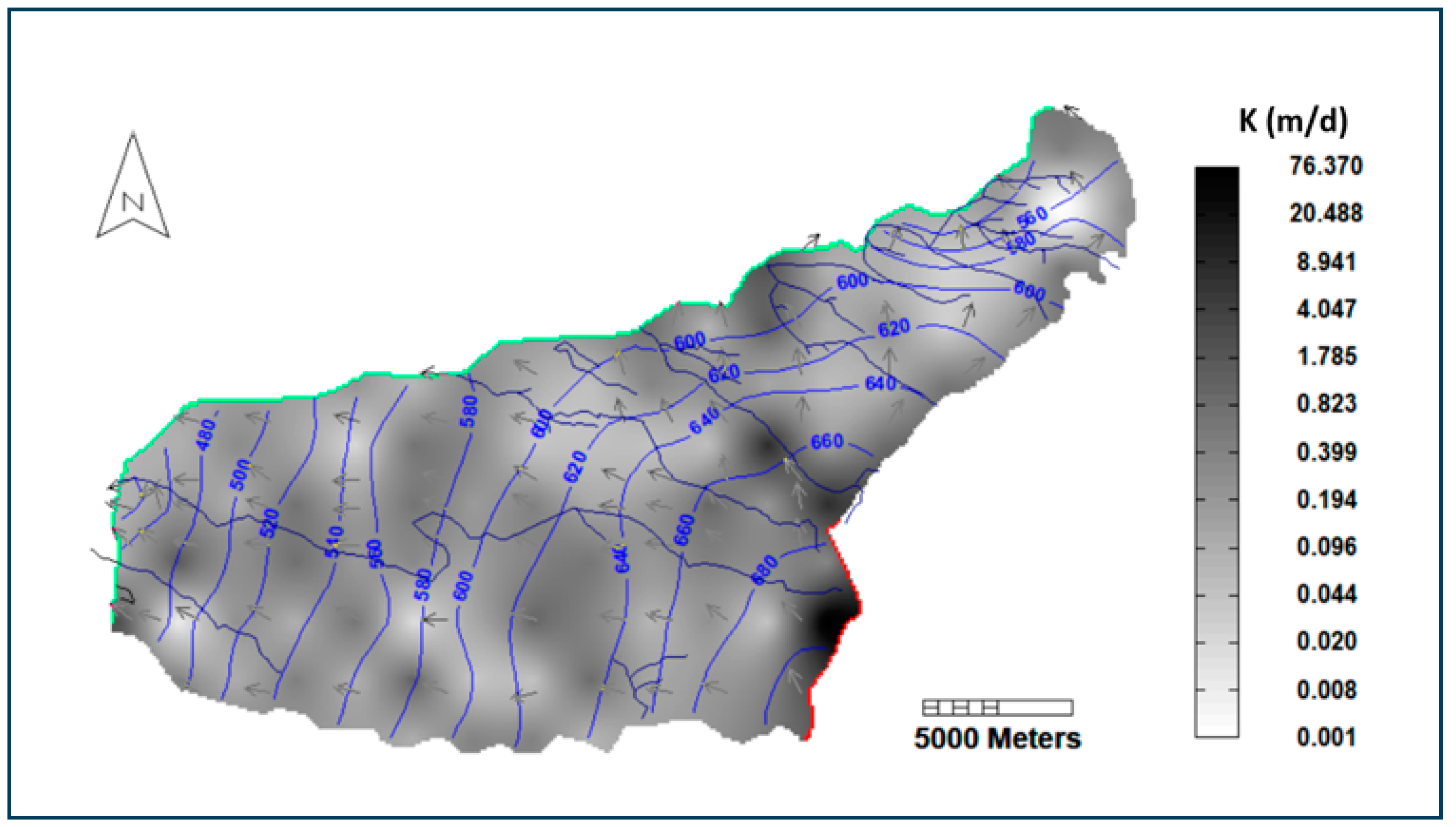
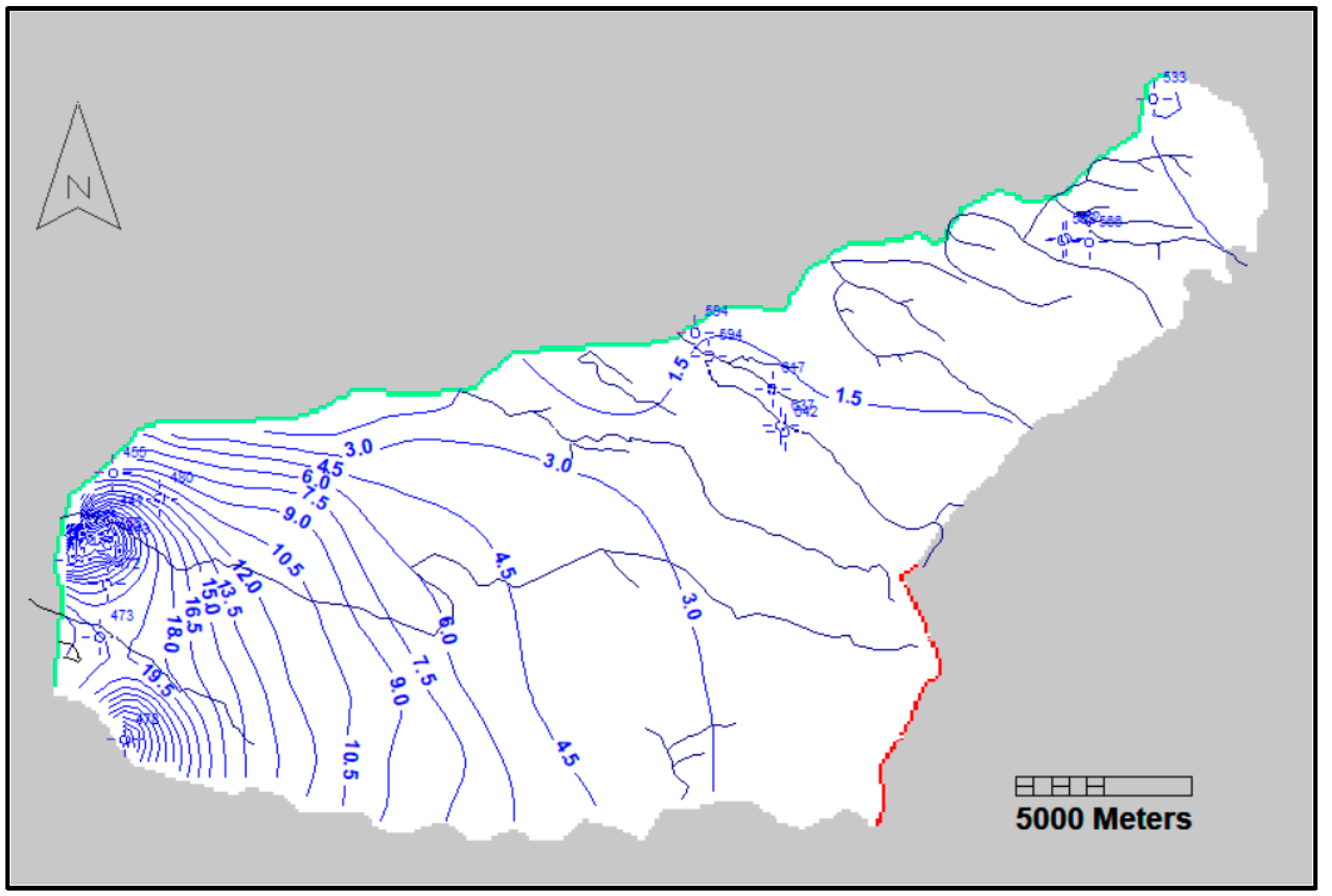

| Wells | Well Name | Depth/Soil (m) | X | Y | Q (m3/d) | Observed Head (m) | Simulated DD (m) |
|---|---|---|---|---|---|---|---|
| Eastern part | DBol1 | 93 | 242,700 | 1,240,500 | −1500 | 533 | 14.3 |
| Awr3 | 138 | 240,104 | 1,236,460 | - | 562 | - | |
| Awr4 | 144 | 240,857 | 1,236,402 | - | 566 | - | |
| Awr5 | 150 | 240,200 | 1,236,500 | - | 552 | - | |
| Central part | Dad1 | 174 | 231,800 | 1,232,200 | −105 | 617 | 4.0 |
| Dad3 | 139 | 229,593 | 1,233,808 | −100 | 594 | 1.2 | |
| Dad6 | 129 | 229,983 | 1,233,148 | −400 | 594 | 6.6 | |
| DjG | 142 | 232,154 | 1,230,969 | - | 642 | - | |
| MDk | 140 | 232,045 | 1,231,147 | - | 637 | - | |
| Western part | Dik1 | 90 | 212,870 | 1,228,410 | −400 | 441 | 37.5 |
| Dik2 | 103 | 213,015 | 1,227,578 | −800 | 443 | 43.6 | |
| Dik3 | 125 | 212,108 | 1,228,017 | −700 | 413 | 55.7 | |
| Dik6 | 94 | 212,809 | 1,227,763 | −700 | 436 | 50.4 | |
| Dik8 | 120 | 211,795 | 1,227,327 | −800 | 412 | 59.4 | |
| Dik9 | 141 | 214,288 | 1,229,082 | - | 480 | - | |
| Dik11 | 102 | 212,949 | 1,229,810 | - | 455 | - | |
| Dik12 | 135 | 212,781 | 1,226,616 | - | 472 | - | |
| Dik14 | 121 | 212,574 | 1,225,106 | - | 473 | - | |
| Dbd2 | 123 | 213,288 | 1,222,184 | −900 | 478 | 45.7 |
| Min (mm) | Max (mm) | Average (mm) | SD (mm) | CV (%) | |
|---|---|---|---|---|---|
| DIA | 3.0 | 481.0 | 146.0 | 122 | 84 |
| Dikhil | 20.6 | 246.7 | 136.2 | 56 | 41 |
| Scenario | Average | CI (95%) | Minimum | Maximum | SD | CV (%) |
|---|---|---|---|---|---|---|
| RCP 2.6 | 243.7 | 224 < m < 263 | 91.7 | 841.2 | 100.6 | 41 |
| Component | Inflow (m3/Year) | Outflow (m3/Year) |
|---|---|---|
| Upstream border with Ethiopia | 2.67 × 106 | --- |
| Recharge | 3.97 × 106 | --- |
| Downstream boundary | 1.12 × 106 | 5.31 × 106 |
| Evapotranspiration | --- | 0.11 × 106 |
| Pumpage | --- | 2.34 × 106 |
| TOTAL | 7.76 × 106 | 7.76 × 106 |
| Well Group | Name | X | Y | Optimized Discharge Q m3/d | Total Q per Group | % of Each Group vs. Total Q |
|---|---|---|---|---|---|---|
| East | Aw3 | 240,104 | 1,236,460 | 85.6 | 1283.3 | 15% |
| Aw4 | 240,857 | 1,236,402 | 90.3 | |||
| Aw5 | 240,200 | 1,236,500 | 107.4 | |||
| DBol1 | 242,700 | 1,240,500 | 1000.0 | |||
| Center | DjG | 232,154 | 1,230,969 | 503.7 | 3619.5 | 43% |
| MDk | 232,045 | 1,231,147 | 553.6 | |||
| Dad1 | 231,800 | 1,232,200 | 574.8 | |||
| Dad3 | 229,593 | 1,233,808 | 1000.0 | |||
| Dad6 | 229,983 | 1,233,148 | 987.4 | |||
| West | Dik1 | 212,870 | 1,228,410 | 231.2 | 3476.9 | 42% |
| Dik11 | 212,949 | 1,229,810 | 296.8 | |||
| Dik12 | 212,781 | 1,226,616 | 562.0 | |||
| Dik14 | 212,574 | 1,225,106 | 562.1 | |||
| Dik2 | 213,015 | 1,227,578 | 347.0 | |||
| Dik3 | 212,108 | 1,228,017 | 220.5 | |||
| Dik6 | 212,809 | 1,227,763 | 219.6 | |||
| Dik8 | 211,795 | 1,227,327 | 239.4 | |||
| Dik9 | 214,288 | 1,229,082 | 346.9 | |||
| Dbd2 | 213,288 | 1,222,184 | 451.4 | |||
| Total daily pumpage | 8379.7 m3/d | |||||
| Total annual pumpage | 3.06 Mm3/year | |||||
| Average annual recharge | 3.86 Mm3/year | |||||
| Ratio of total abstraction to recharge (%) | 79% | |||||
| Well Group | Name | X | Y | Well Discharge Q m3/d |
|---|---|---|---|---|
| East | Aw3 | 240,104 | 1,236,460 | 41.7 |
| Aw4 | 240,857 | 1,236,402 | 45.9 | |
| Aw5 | 240,200 | 1,236,500 | 52.9 | |
| DBol1 | 242,700 | 1,240,500 | 500.0 | |
| Center | DjG | 232,154 | 1,230,969 | 249.2 |
| MDk | 232,045 | 1,231,147 | 272.0 | |
| Dad1 | 231,800 | 1,232,200 | 295.3 | |
| Dad3 | 229,593 | 1,233,808 | 500.0 | |
| Dad6 | 229,983 | 1,233,148 | 500.0 |
Disclaimer/Publisher’s Note: The statements, opinions and data contained in all publications are solely those of the individual author(s) and contributor(s) and not of MDPI and/or the editor(s). MDPI and/or the editor(s) disclaim responsibility for any injury to people or property resulting from any ideas, methods, instructions or products referred to in the content. |
© 2025 by the authors. Licensee MDPI, Basel, Switzerland. This article is an open access article distributed under the terms and conditions of the Creative Commons Attribution (CC BY) license (https://creativecommons.org/licenses/by/4.0/).
Share and Cite
Razack, M.; Jalludin, M.; Birhanu, B. Water Resource Assessment and Management in Dalha Basalts Aquifer (SW Djibouti) Using Numerical Modeling. Hydrology 2025, 12, 73. https://doi.org/10.3390/hydrology12040073
Razack M, Jalludin M, Birhanu B. Water Resource Assessment and Management in Dalha Basalts Aquifer (SW Djibouti) Using Numerical Modeling. Hydrology. 2025; 12(4):73. https://doi.org/10.3390/hydrology12040073
Chicago/Turabian StyleRazack, Moumtaz, Mohamed Jalludin, and Behailu Birhanu. 2025. "Water Resource Assessment and Management in Dalha Basalts Aquifer (SW Djibouti) Using Numerical Modeling" Hydrology 12, no. 4: 73. https://doi.org/10.3390/hydrology12040073
APA StyleRazack, M., Jalludin, M., & Birhanu, B. (2025). Water Resource Assessment and Management in Dalha Basalts Aquifer (SW Djibouti) Using Numerical Modeling. Hydrology, 12(4), 73. https://doi.org/10.3390/hydrology12040073








